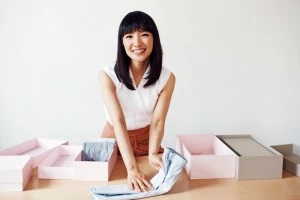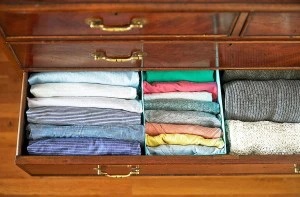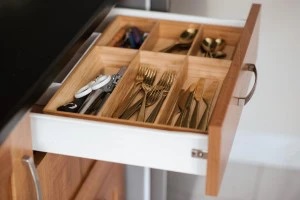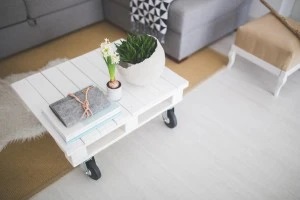Tidying using the KonMari Method
Your Ultimate Guide to Tidying using the KonMari Method
Marie Kondo’s Netflix show, Tidying Up with Marie Kondo has been a recent worldwide success. Released at the start of 2019 to coincide with New Year Resolutions and start of the year clean-outs, the series has taken on a life of its own.
In this reality TV show, Kondo helps families to declutter their homes and transform their lives using her unique KonMari Method for tidying. Each episode sees Kondo arrive to a cluttered and disorganised house in need of some assistance that typically extends beyond their messy home.
She begins by greeting the house, which involves kneeling on the floor with her eyes closed then pressing her hands into the floor as she bows. This is a practice that seems to take most of the households by surprise but is an element Kondo insists on before getting started.
Whether it’s a result of Kondo’s joy and charm or her innovative method for tidying that’s attracted the world’s attention, there’s no denying the KonMari method has had worldwide appeal.
Are you ready to start tidying your home using the KonMari method? Or do you have no idea what the KonMari method is?
Read on to discover everything you need to know about Marie Kondo and how to tidy using her KonMari method.
Who is Marie Kondo?

Marie Kondo is a Japanese tidying expert and author. She started her career in tidying and organisation when she was just nineteen years old and claims she loves to tidy up mess.
Her approach to tidying is in part inspired by the Shinto religion. She spent five years spent as an attendant maiden at a Shinto shrine and you can see her religious influence in the way she greets each house and thanks items no longer needed.
After starting her own tidying business she went on to write four books on tidying up including her Number 1 New York Times bestselling book, “The Life-Changing Magic of Tidying Up.”
Since then she has been featured on radio and in newspapers and magazines all over the world and in 2015 was listed as one the Time’s 100 Most Influential People.
How is it Different to Other Tidying Methods?
Most other tidying methods suggest working through your house one room at a time. With the KonMari Method you work through your belongings in categories rather than by location.
The categories should be worked through in the following order:
- Clothing
- Books
- Papers
- Komono (miscellaneous items)
- Sentimental items
Another major point of difference is that the KonMari methods asks people to be more mindful and introspective about the items that fill their homes, focusing on items that bring joy.
Kondo also encourages people to thank their items before they discard them – something not typically suggested in other methods of cleaning up.
With Marie Kondo’s approach, every member of the household needs to be involved too as it’s important each person has ownership over their own area and items. Children should be allowed to tell you which toys and clothes of theirs sparks joy, and all members of the household will need to help gather items to sort as the categories often span across all rooms of the house.

Does it Spark Joy?
Kondo focuses on the notion that everything you own should “spark joy”. This is perhaps the most well-known area of the KonMari method and an integral part of her approach to tidying up.
Tidying using this method involves holding each item and asking yourself: Does this spark joy in my life? If it does, Kondo says there will be a physical reaction in your body. She displays this on her TV show by pointing one finger in the air, lifting the opposite foot off the ground and saying “ting!”
If the item sparks joy for you, you keep it. If it doesn’t, you discard it.
Kondo believes you get better at recognising this feeling in your body which is why she recommends tidying in a specific order, leaving sentimental items until last.
This is probably one of the most unique and controversial elements of Kondo’s tidying method, receiving plenty of criticism from media and its fair share of jokes.
While the joy element can be a challenging idea for some people to take on board, acknowledging there are items which no longer serve a purpose or fill a need can be very helpful to the tidying up and decluttering process.
The KonMari Method in Action
The method Marie Kondo uses for tidying up success is called the KonMari Method.
This method uses 6 basic rules:
- Commit to tidying up
- Imagine your ideal lifestyle
- Finish discarding first
- Tidy by category not location
- Follow the right order
- Ask yourself if it sparks joy
Before you start, you need to make a commitment to complete the tidying process. This is mainly because it can take a long time to complete your whole house using this method and things will probably look worse before they get better.
Kondo also asks you to imagine what your ideal lifestyle looks like so you know what you’re trying to achieve with the tidying process. Do you want more space in your house, less clutter, more time to spend with your family? Imagine what your life will look like once you have completed the tidying process before you even begin.
Next, you begin working through the KonMari categories in the following order:
Clothing
Kondo suggests you start the tidying process with clothing.
To being, gather every piece of clothing you own and place it in one large pile. The main purpose of this is so you can see exactly how much clothing you own. For most people this step will be a real eye-opener, highlighting the fact that we often have far more clothing than we actually need or use. Placing all of your clothing together also means your wardrobe space is now empty and ready to be organised in the Marie Kondo way.

Now, work through the pile by holding each piece of clothing individually in your hands and asking if it sparks joy for you. If it does, place it in a pile to keep. If it doesn’t, thank the piece of clothing for its service and place it in a bag to be donated.
Once you’ve sorted through all the clothing, it’s time to put it away in the KonMari way. Kondo suggests folding items in a precise manner which maximises space and allows you to see all of your items clearly when you open your drawers. First, lay the item out and smooth it flat. Then, fold the edges into the middle to create a large rectangle shape (fold sleeves of shirts over so they are out of the way). Next, fold the rectangle carefully in half and then again to form a smaller rectangle that can stand upright (watch this video to see how it’s done). Items should then be placed standing up in rows.
When it comes to socks Kondo says they should never be rolled together as this stretches them and doesn’t show them the appropriate amount of respect. They should be placed one on top of the other and folded over in the same way as other clothing. You can then stand them up and stack them together inside the drawer (watch this video for a more detailed look).
Books
Books are next on the list. Gather books from all the locations around the house and place in piles the same as you did with your clothing. Kondo can be seen on the Netflix program giving the book piles a tap to ‘wake them up’ before she starts.
Again, hold each book and ask if it sparks joy for you. Place in appropriate piles according to your response.
Marie Kondo herself claims to only own thirty books but doesn’t say everyone should stick to this number. She does, however, believe that if you haven’t already read the book you probably won’t get to it and should throw it away. She also says books that have already been read will seldom be re-read and should also be gotten rid of (not everyone is happy about that approach – read more on that later)
Once you’ve sorted through your book pile, place them all neatly away again.
Papers
Marie Kondo believes that the best way to tidy up papers and documents is to throw them away. While this may seem extreme, we do often hold onto things that serve no purpose (and certainly don’t bring us joy).
While we don’t suggest you start throwing away every piece of paper in your house with reckless abandon, you should definitely consider if you really need to keep pieces of paper or not.
The best way to organise your documents is into these categories:
- Papers that need your attention
- Papers that you need in the short-term
- Papers you need to keep forever
Once you’ve sorted your current paper pile, try to limit the amount of paper that comes into the house. Opt for paperless when it comes to bill, statements and receipts wherever possible. Open your mail as it arrives and deal with it on the spot rather than letting it pile up.
Komono (miscellaneous items)
This is often the largest clutter category and the most time-consuming to sort through.
The Komono category is the one category that will contain items from all areas of your house so it can help to work through it in subcategories such as:
- CDs, DVDs
- Skin care and beauty products
- Electrical equipment and appliances
- Linens
- Kitchen items
- Hobby and craft items
- Seasonal items and decorations
- Home decor/furniture

Gather items into piles and sort according to whether or not they bring you joy.
Kondo believes that every item should have a place so it’s important your items are placed away into a sensible, tidy location after the sorting process is completed.
Once you’re done with your physical komono you can also work to declutter your digital komono using the same method. Delete excess emails, clean up your computer desktop and place apps on your phone into organised folders.
Sentimental Items
By the time you’re ready to sort through your sentimental items, you should already be familiar with the KonMari method and recognising when an item sparks joy for you. This is why Kondo leaves this category until the end – so there’s no risk of ridding yourself of important items without proper thought and care.
Gather your sentimental items and follow the process of handling each item and seeing if it sparks joy. Some items might be important but no longer serve you and it’s important to recognise this. Thank these items in a heartfelt way but still commit to letting them go and clearing space for other things.
When it comes to items like children’s artwork you could take photos of it before throwing it away. You can use this method with other sentimental items as well, allowing you to hold on to a symbol of the item in the form of a photo, which is sometimes all that is needed for you to feel okay about parting with the item.
Criticisms of the KonMari Approach
While there’s no doubting it is popular, not everyone is a fan of the KonMari approach to tidying. Criticisms range from practicality to cultural issues and environmental concerns.
Kondo claims that once people have completed the KonMari method on their homes, they will NEVER need to declutter again. The Netflix series doesn’t revisit families to check in with them after their tidying has been completed so it’s hard to know whether this is true, but there are plenty of people who disagree that the KonMari method is a one-time-only deal.
Some people with small children also take issue with this idea as children are notorious for collecting junk and not being too great at tidying up, making it less likely to be successful in the long-term.
The KonMari process itself also doesn’t account for new things being brought into the house both through the tidying process or after it has been completed.
Another common critique of this method is the environmental aspect of throwing out items. Kondo suggests getting rid of everything that doesn’t spark joy – which usually ends up being quite a substantial amount of waste. Some believe Kondo should encourage people to recycle and donate items and also suggest a more minimalist approach to buying things. While you can see Kondo hopes people will become more mindful in their purchasing after the tidying process is complete, she doesn’t explicitly teach or encourage minimalism in her approach.
A major source of controversy has come from the KonMari method to sorting books. Marie Kondo states she only owns thirty books and the idea that others are expected to follow suit has caused some outrage amongst booklovers.
Marie Kondo has years of experience helping people in Japan to tidy their spaces. Another criticism is that this approach to tidying might not be appropriate for other areas of the world where living spaces are bigger (on average) and there may be different cultural perceptions about possessions and organisation too.
Choose What Works For You
Love or hate Marie Kondo and her unique approach to tidying and organisation, it’s important you approach decluttering in a way that works for you. That might mean following the KonMari approach faithfully, tweaking some areas to suit your individual requirements, or following another approach to tidying entirely.
One thing’s for sure though – coming home to a tidy and organised house sounds like a dream come true!
Are you moving home soon? Hire A Mover can help with our professional removal services. Hire A Packer offers professional packing, unpacking and de-cluttering services. Hire A Box can supply you with the boxes and packing materials.

